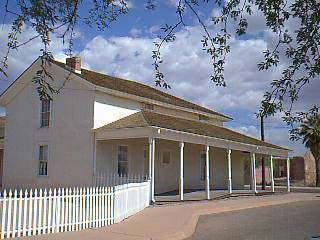[Source: Bonnie Bariola, TriValeyCentral.com]

A ceremony was held for the reopening of McFarland State Historic Park in conjunction with the Annual Tour of Historic Florence [last] Saturday.
Leah Lewis, granddaughter of Ernest W. McFarland, was Master of Ceremonies. She told about times with her grandfather when she was a small child, saying he was always interested in their school work and encouraged them to further their educations. She also reminded everyone that her grandfather was the only person to hold the three positions of U. S. senator, governor and chief justice of the Arizona Supreme Court.
Mayor Vicki Kilvinger related to those present how much the GI Bill had meant to her and her husband. Thanks to Senator McFarland for helping create the GI Bill, her husband was able to complete his education and become a rocket scientist after having served in the military. Her presentation was very touching and inspiring, saying that through the efforts of Senator McFarland, her family’s life as well as that of many other service people, had been made easier.
Jim Garrison, State Historic Preservation Officer, explained how the first Pinal County Courthouse was purchased by Ernest McFarland and donated to the Arizona State Parks System to become McFarland Historic State Park.
Renee Bahl, executive director of Arizona State Parks, told about the recent renovation of the park. Unfortunately, as construction was nearing completion the state’s economy collapsed and no funding was available to reopen it. Through negotiations, the town of Florence was able to lease and reopen the park with the Florence Main Street Program operating it under the auspices of Manager Jennifer Evans.
Jennifer Evans is also the manager of the Florence Visitor Center, also housed at the park. For further information, you may contact her or her assistant, Ken Loerzel at 520-868-4496 or e-mailinfo@florencemainstreet.com.
 [Source: Florence Reminder, Bonnie Bariola 1-21-2010] — Of the five Arizona State Parks located in Pinal County, only one is slated to remain open. The reason being that in 1976 the Arizona State Parks Board entered into an agreement with the Boyce Thompson Arboretum Board and the University of Arizona to cooperatively manage the park. All funding for the Arboretum from the Arizona State Parks Board will stop, leaving the Arboretum to be funded through the University of Arizona and the Boyce Thompson Foundation.
[Source: Florence Reminder, Bonnie Bariola 1-21-2010] — Of the five Arizona State Parks located in Pinal County, only one is slated to remain open. The reason being that in 1976 the Arizona State Parks Board entered into an agreement with the Boyce Thompson Arboretum Board and the University of Arizona to cooperatively manage the park. All funding for the Arboretum from the Arizona State Parks Board will stop, leaving the Arboretum to be funded through the University of Arizona and the Boyce Thompson Foundation.